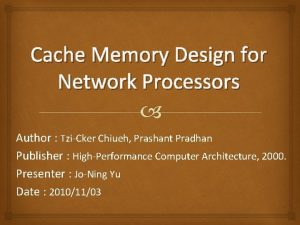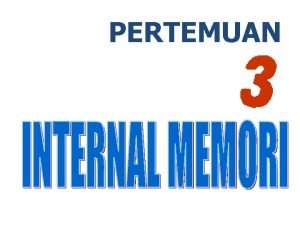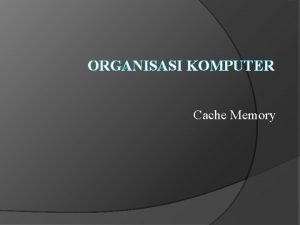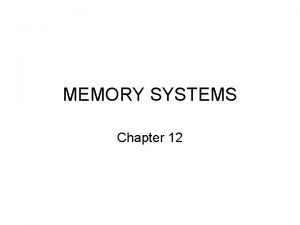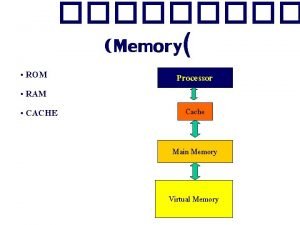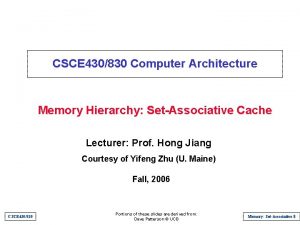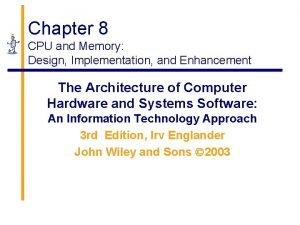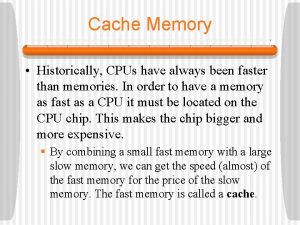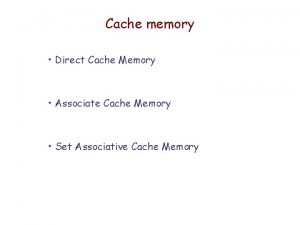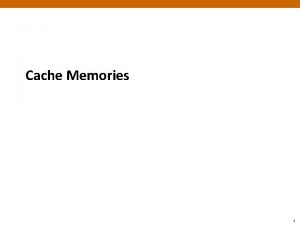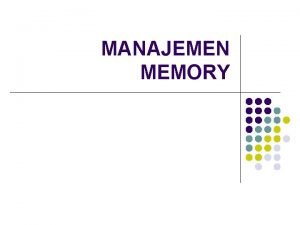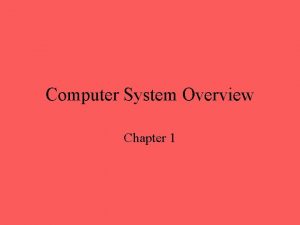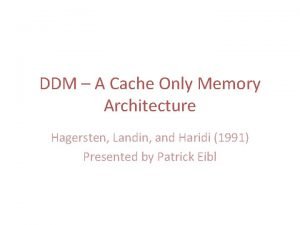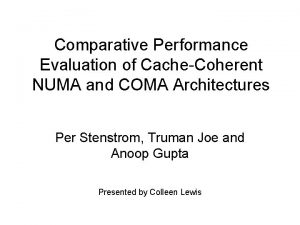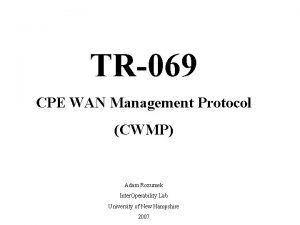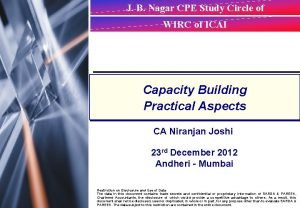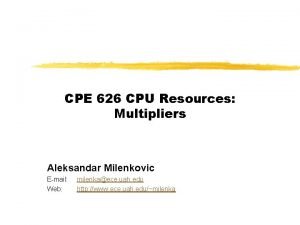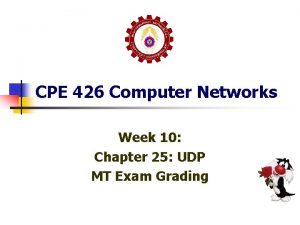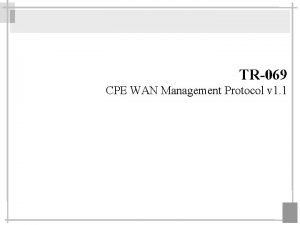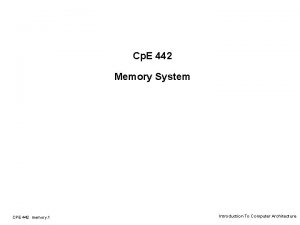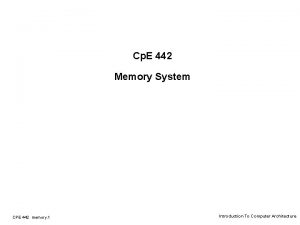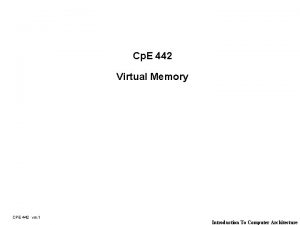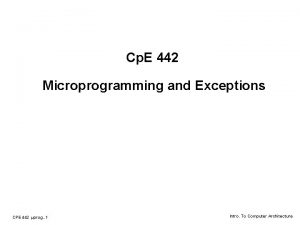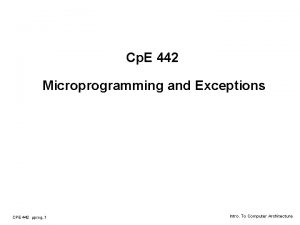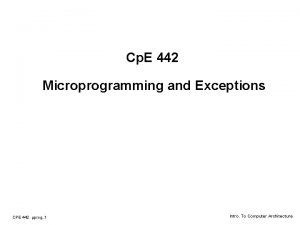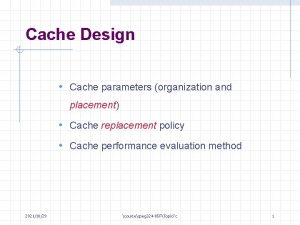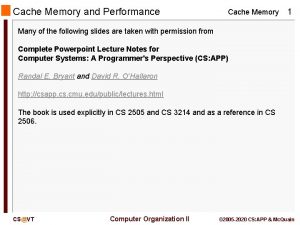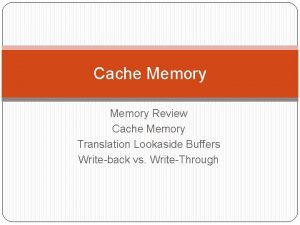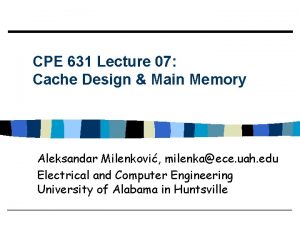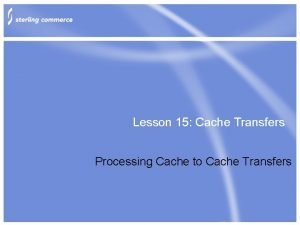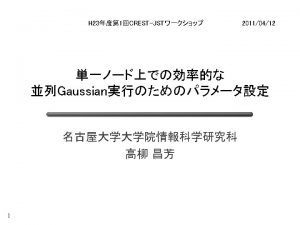Cp E 442 Cache Memory Design CPE 442














































- Slides: 46

Cp. E 442 Cache Memory Design CPE 442 cache. 1 Introduction To Computer Architecture

Outline of Today’s Lecture ° Recap of Memory Hierarchy & Introduction to Cache (20 min) ° A In-depth Look at the Operation of Cache (25 min) ° Cache Write and Replacement Policy (10 min) ° Reducing Memory Transfer Time using memory interleaving (5 min) ° The Memory System of the SPARCstation 20 (10 min) ° Summary (5 min) CPE 442 cache. 2 Introduction To Computer Architecture

Recap: SRAM Timing A N WE_L OE_L 2 N words x M bit SRAM M Write Timing: D A D Read Timing: Data In Write Address High Z Junk Garbage Data Out Read Address Junk Data Out Read Address OE_L Write Hold Time Write Setup Time CPE 442 cache. 3 Read Access Time Introduction To Computer Architecture

Recap: DRAM Fast Page Mode Operation ° After a row is read into the register • Only CAS is needed to access other M-bit blocks on that row • RAS_L remains asserted while CAS_L is toggled N cols DRAM Row Address N rows ° Fast Page Mode DRAM • N x M “SRAM” to save a row Column Address N x M “SRAM” M bits M-bit Output 1 st M-bit Access 2 nd M-bit 3 rd M-bit 4 th M-bit Col Address RAS_L CAS_L A Row Address CPE 442 cache. 4 Col Address Introduction To Computer Architecture

The Motivation for Caches Memory System Processor Cache DRAM ° Motivation: • Large memories (DRAM) are slow • Small memories (SRAM) are fast ° Make the average access time small by: • Servicing most accesses from a small, fast memory. ° Reduce the bandwidth required of the large memory CPE 442 cache. 5 Introduction To Computer Architecture

An Expanded View of the Memory System Processor Control Memory Speed: Fastest Size: Smallest Cost: Highest CPE 442 cache. 6 Memory Datapath Memory Slowest Biggest Lowest Introduction To Computer Architecture

Levels of the Memory Hierarchy Upper Level Capacity Access Time Cost Staging Xfer Unit CPU Registers 100 s Bytes <10 s ns Registers Cache K Bytes 10 -100 ns $. 01 -. 001/bit Cache Instr. Operands Blocks Main Memory M Bytes 100 ns-1 us $. 01 -. 001 Disk G Bytes ms -4 -3 10 - 10 cents Tape infinite sec-min 10 -6 CPE 442 cache. 7 faster prog. /compiler 1 -8 bytes cache cntl 8 -128 bytes Memory Pages OS 512 -4 K bytes Files user/operator Mbytes Disk Tape Larger Lower Level Introduction To Computer Architecture

The Principle of Locality Probability of reference 0 Address Space 2 ° The Principle of Locality: • Program access a relatively small portion of the address space at any instant of time. • Example: 90% of time in 10% of the code ° Two Different Types of Locality: • Temporal Locality (Locality in Time): If an item is referenced, it will tend to be referenced again soon. • Spatial Locality (Locality in Space): If an item is referenced, items whose addresses are close by tend to be referenced soon. CPE 442 cache. 8 Introduction To Computer Architecture

Memory Hierarchy: Principles of Operation ° At any given time, data is copied between only 2 adjacent levels: • Upper Level (Cache) : the one closer to the processor - Smaller, faster, and uses more expensive technology • Lower Level (Memory): the one further away from the processor - Bigger, slower, and uses less expensive technology ° Block: • The minimum unit of information that can either be present or not present in the two level hierarchy To Processor Upper Level (Cache) Lower Level (Memory) Blk X From Processor CPE 442 cache. 9 Blk Y Introduction To Computer Architecture

Memory Hierarchy: Terminology ° Hit: data appears in some block in the upper level (example: Block X) • Hit Rate: the fraction of memory access found in the upper level • Hit Time: Time to access the upper level which consists of RAM access time + Time to determine hit/miss ° Miss: data needs to be retrieve from a block in the lower level (Block Y) • Miss Rate = 1 - (Hit Rate) • Miss Penalty = Time to replace a block in the upper level + Time to deliver the block the processor ° Hit Time << Miss Penalty To Processor Upper Level (Cache) Lower Level (Memory) Blk X From Processor CPE 442 cache. 10 Blk Y Introduction To Computer Architecture

Basic Terminology: Typical Values Block (line) size Hit time 4 - 128 bytes 1 - 4 cycles Miss penalty 8 - 32 cycles (access time) (6 -10 cycles) (transfer time) (2 - 22 cycles) Miss rate 1% - 20% Cache Size 1 KB - 256 KB CPE 442 cache. 11 (and increasing) Introduction To Computer Architecture

Outline of Today’s Lecture ° Recap of Memory Hierarchy & Introduction to Cache (20 min) ° A In-depth Look at the Operation of Cache ° Cache Write and Replacement Policy (10 min) ° The Memory System of the SPARCstation 20 (10 min) ° Summary (5 min) CPE 442 cache. 12 Introduction To Computer Architecture

How Does Cache Work? ° Temporal Locality (Locality in Time): If an item is referenced, it will tend to be referenced again soon. • Keep more recently accessed data items closer to the processor ° Spatial Locality (Locality in Space): If an item is referenced, items whose addresses are close by tend to be referenced soon. • Move blocks consists of contiguous words to the cache To Processor Upper Level Cache Lower Level Memory Blk X From Processor CPE 442 cache. 13 Blk Y Introduction To Computer Architecture

The Simplest Cache: Direct Mapped Cache Design Memory Address 0 1 2 3 4 5 6 7 8 9 A B C D E F CPE 442 cache. 14 Memory Block i in MM maps to Block Frame i mod k in Cache, k = total number of Block Frames Cache Index 0 1 2 3 4 Byte Direct Mapped Cache k = 4, Block Frame size = 1 Byte ° Location 0 can be occupied by data from: • Memory locations 0, 4, 8, . . . etc. • In general: any memory location whose 2 LSBs of the address are 0 s • Address<1: 0> => cache index ° Which one should we place in the cache? ° How can we tell which one is in the cache? Introduction To Computer Architecture

Cache Tag and Cache Index ° Assume a 32 -bit memory (byte ) address: • A 2 N bytes direct mapped cache with 1 Byte Blocks: - Cache Index: The lower N bits of the memory address - Cache Tag: The upper (32 - N) bits of the memory address (main memory block address of blocks that map to a given block frame) 31 N Cache Tag Valid Bit Example: 0 x 50 Stored as part of the cache “state” 0 x 50 : : Cache Index 2 N Bytes Direct Mapped Cache Byte 0 Byte 1 Byte 2 Byte 3 Cache Directory 0 1 2 3 : Byte 2**N -1 CPE 442 cache. 15 0 Ex: 0 x 03 2 N- 1 Block Frames Introduction To Computer Architecture

Cache Access Example V Start Up Tag Data Access 000 01 (miss) Access 000 01 (HIT) 000 010 M [00001] M [01010] Miss Handling: Write Tag & Set V Load Data 000 M [00001] Access 010 10 (miss) Access 010 10 (HIT) Load Data Write Tag & Set V 000 010 CPE 442 cache. 16 M [00001] M [01010] ° Sad Fact of Life: • A lot of misses at start up: Compulsory Misses - (Cold start misses) Introduction To Computer Architecture

Definition of a Cache Block ° Cache Block: the cache data that has in its own cache tag ° Our previous “extreme” example: • 4 -byte Direct Mapped cache: Block Size = 1 Byte • Take advantage of Temporal Locality: If a byte is referenced, it will tend to be referenced soon. • Did not take advantage of Spatial Locality: If a byte is referenced, its adjacent bytes will be referenced soon. ° In order to take advantage of Spatial Locality: increase the block size Valid CPE 442 cache. 17 Cache Tag Direct Mapped Cache Data Byte 0 Byte 1 Byte 2 Byte 3 Introduction To Computer Architecture

Example: 1 KB Direct Mapped Cache with 32 B Blocks ° For a 2 ** 10 byte cache: • The uppermost (32 - 10) bits are always the Cache Tag • The lowest 5 bits are the Byte Select • Cache index is 5 bits, k=32 block frames in the cache 31 Cache Tag Example: 0 x 50 9 Cache Index Ex: 0 x 01 4 0 Byte Select Ex: 0 x 00 Stored as part of the cache “state” 0 x 50 : Cache Data Byte 31 Byte 63 : : Byte 1023 CPE 442 cache. 18 Byte 1 Byte 0 0 Byte 33 Byte 32 1 2 3 : Cache Tag : : Valid Bit Byte 992 31 Introduction To Computer Architecture

Review: DECStation 3100 16 K words cache with one word per block CPE 442 cache. 19 Introduction To Computer Architecture

Review: 64 K Direct mapped cache with block size of 4 -words CPE 442 cache. 20 Introduction To Computer Architecture

Block Size Tradeoff ° In general, larger block size take advantage of spatial locality BUT: • Larger block size means larger miss penalty: - Takes longer time to fill up the block • If block size is too big relative to cache size, miss rate will go up ° Average Access Time: • = Hit Time x (1 - Miss Rate) + Miss Penalty x Miss Rate Exploits Spatial Locality Miss Penalty Fewer blocks: compromises temporal locality Block Size CPE 442 cache. 21 Block Size Average Access Time Increased Miss Penalty & Miss Rate Block Size Introduction To Computer Architecture

Another Extreme Example Valid Bit Cache Tag Cache Data Byte 3 Byte 2 Byte 1 Byte 0 0 ° Cache Size = 4 bytes Block Size = 4 bytes • Only ONE block frame in the cache, k=1 ° True: If an item is accessed, likely that it will be accessed again soon • But it is unlikely that it will be accessed again immediately!!! • The next access will likely to be a miss again - Continually loading data into the cache but discard (force out) them before they are used again - Worst nightmare of a cache designer: Ping Pong Effect ° Conflict Misses are misses caused by: • Different memory locations mapped to the same cache index - Solution 1: make the cache size bigger - Solution 2: Multiple entries for the same Cache Index CPE 442 cache. 22 Introduction To Computer Architecture

Fully Associative Cache Design ° Fully Associative Cache – A block in MM maps to any Block Frame in the cache • Forget about the Cache Index, it does not exist in the reference • Compare the Cache Tags of all cache entries in parallel • Example: Block Size = 32 B blocks, we need k 27 -bit comparators, k = 32 block frames in the cache for 1 KB cache ° By definition: Conflict Miss = 0 for a fully associative cache 31 4 0 Byte Select Ex: 0 x 01 Cache Tag (27 bits long) Cache Tag Valid Bit Cache Data Byte 31 Byte 0 Byte 63 Byte 32 : : X X X CPE 442 cache. 23 : : : Introduction To Computer Architecture

Set Associative Cache Design ° N-way set associative: Divide cache into S sets of block Frames, Block i in MM maps to any block Frame in Set i Mod S, with N Block frames per set • N direct mapped caches operating in parallel N = k/S, N=1 -> direct mapped ° Example: Two-way set associative cache, N=2 N=k -> fully associative • Cache Index selects a “set” from the cache • The two tags in the set are compared in parallel • Data is selected based on the tag result Valid Cache Tag : : Adr Tag Compare Cache Data Cache Index Cache Data Cache Block 0 Set 0 Cache Block 1 : : Sel 1 1 Mux 0 Sel 0 Cache Tag Valid : : Compare OR Hit CPE 442 cache. 24 Cache Block Introduction To Computer Architecture

Disadvantage of Set Associative Cache ° N-way Set Associative Cache versus Direct Mapped Cache: • N comparators vs. 1 • Extra MUX delay for the data • Data comes AFTER Hit/Miss ° In a direct mapped cache, Cache Block is available BEFORE Hit/Miss: • Possible to assume a hit and continue. Recover later if miss. Valid Cache Tag : : Adr Tag Compare Cache Index Cache Data Cache Block 1 Cache Block 0 : : Sel 1 1 Mux 0 Sel 0 Cache Tag Valid : : Compare OR CPE 442 cache. 25 Hit Cache Block Introduction To Computer Architecture

A Summary on Sources of Cache Misses ° Compulsory (cold start, first reference): first access to a block • “Cold” fact of life: not a whole lot you can do about it ° Conflict (collision): main problem with direct mapped cache • Multiple memory locations mapped to the same cache location • Solution 1: increase cache size • Solution 2: increase associativity ° Capacity: • Cache cannot contain all blocks access by the program • Solution: increase cache size ° Invalidation: other process (e. g. , I/O) updates memory CPE 442 cache. 26 Introduction To Computer Architecture

Outline of Today’s Lecture ° Recap of Memory Hierarchy & Introduction to Cache (20 min) ° A In-depth Look at the Operation of Cache (25 min) ° Cache Write and Replacement Policy • Write Policy ° The Memory System of the SPARCstation 20 (10 min) ° Summary (5 min) CPE 442 cache. 28 Introduction To Computer Architecture

The Need to Make a Decision! Which block to replace when a new block is fetched on a cache miss? (Replacement Policy, Depends on the Placement Policy) ° Direct Mapped Cache: • Each memory location can only mapped to 1 cache location • No need to make any decision : -) - Current item replaced the previous item in that cache location ° N-way Set Associative Cache: • Each memory location have a choice of N cache locations ° Fully Associative Cache: • Each memory location can be placed in ANY cache location ° Cache miss in a N-way Set Associative or Fully Associative Cache: • Bring in new block from memory • Throw out a cache block to make room for the new block • We need to make a decision on which block to throw out! CPE 442 cache. 29 Introduction To Computer Architecture

Cache Block Replacement Policy ° Random Replacement: • Hardware randomly selects a cache item and throw it out ° Least Recently Used: • Hardware keeps track of the access history • Replace the entry that has not been used for the longest time ° Example of a Simple “Pseudo” Least Recently Used Implementation: • Assume 64 Fully Associative Entries • Hardware replacement pointer points to one cache entry • Whenever an access is made to the entry: - Move the pointer to the next entry Entry 0 • Otherwise: do not move the pointer Entry 1 Replacement Pointer : Entry 63 CPE 442 cache. 30 Introduction To Computer Architecture

Outline of Today’s Lecture ° Recap of Memory Hierarchy & Introduction to Cache (20 min) ° A In-depth Look at the Operation of Cache (25 min) ° Cache Write and Replacement Policy • Write Policy ° The Memory System of the SPARCstation 20 (10 min) ° Summary (5 min) CPE 442 cache. 31 Introduction To Computer Architecture

Cache Write Policy: When to update main memory on a write access to the cache? Write Through (WT) versus Write Back (WB) ° Cache read is much easier to handle than cache write: • Instruction cache is much easier to design than data cache ° Cache writes: • How do we keep data in the cache and memory consistent? ° Two options (decision time again : -) • Write Back: write to cache only. Write the cache block to memory when that cache block is being replaced on a cache miss. - Need a “dirty” bit for each cache block - Greatly reduce the memory bandwidth requirement - Control can be complex • Write Through: write to cache and memory at the same time. - What!!! How can this be? Isn’t memory too slow for this? CPE 442 cache. 32 Introduction To Computer Architecture

Write Buffer for Write Through Processor Cache DRAM Write Buffer ° A Write Buffer is needed between the Cache and Memory • Processor: writes data into the cache and the write buffer • Memory controller: write contents of the buffer to memory ° Write buffer is just a FIFO: • Typical number of entries: 4 • Works fine if: Store frequency (w. r. t. time) << 1 / DRAM write cycle ° Memory system designer’s nightmare: • Store frequency (w. r. t. time) -> 1 / DRAM write cycle • Write buffer saturation CPE 442 cache. 33 Introduction To Computer Architecture

Write Buffer Saturation Processor Cache DRAM Write Buffer ° Store frequency (w. r. t. time) -> 1 / DRAM write cycle • If this condition exist for a long period of time (CPU cycle time too quick and/or too many store instructions in a row): - Store buffer will overflow no matter how big you make it - The CPU Cycle Time <= DRAM Write Cycle Time ° Solution for write buffer saturation: • Use a write back cache • Install a second level (L 2) cache: Processor Cache L 2 Cache DRAM Write Buffer CPE 442 cache. 34 Introduction To Computer Architecture

Write Allocate versus Not Allocate (on a write miss) ° Assume: a 16 -bit write to memory location 0 x 0 and causes a miss • Do we read in the rest of the block (Byte 2, 3, . . . 31)? Yes: Write Allocate No: Write Not Allocate 31 9 4 Cache Tag 0 x 00 : Cache Index Ex: 0 x 00 Cache Data Byte 31 Byte 63 Byte 1 Byte 0 0 Byte 33 Byte 32 1 2 3 : : Byte 1023 CPE 442 cache. 35 Byte Select Ex: 0 x 00 : Valid Bit Example: 0 x 00 : : Cache Tag 0 Byte 992 31 Introduction To Computer Architecture

What is a Sub-block? ° Sub-block: • A unit within a block that has its own valid bit • Example: 1 KB Direct Mapped Cache, 32 -B Block, 8 -B Sub-block - Each cache entry will have: 32/8 = 4 valid bits Cache Data B 31 B 24 Sub-block 3 Sub-block 2 : Cache Tag : : Byte 1023 CPE 442 cache. 36 B 7 B 0 0 Sub-block 1 Sub-block 0 1 2 3 : SB 3’s V Bit SB 2’s V Bit SB 1’s V Bit SB 0’s V Bit ° Write miss: only the bytes in that sub-block is brought in. Byte 992 31 Introduction To Computer Architecture

Outline of Today’s Lecture ° Recap of Memory Hierarchy & Introduction to Cache (20 min) ° A In-depth Look at the Operation of Cache (25 min) ° Cache Write and Replacement Policy (10 min) ° Reducing Memory Transfer Time using memory interleaving ° The Memory System of the SPARCstation 20 (10 min) ° Summary (5 min) CPE 442 cache. 37 Introduction To Computer Architecture

Reducing Memory Transfer Time using memory interleaving Fig. 7. 11, p 489 text CPU $ bus mux $ bus M M CPU $ bus M M Solution 2 Solution 1 Solution 3 Wide Path Between Memory & Cache High BW DRAM Memory Interleaving (Needs many (Wider Bus, (a block can be accessed bus cycles) a block can be accessed in one bus cycle, In a few number of cycles, Examples: expensive and more complex) less expensive, and less complex Page Mode DRAM SDRAM Cost CDRAM RAMbus CPE 442 cache. 38 Introduction To Computer Architecture

Increasing Bandwidth - Interleaving Access Pattern without Interleaving: D 1 available Start Access for D 1 CPU Memory Start Access for D 2 Memory Bank 0 Access Pattern with 4 -way Interleaving: CPU Memory Bank 1 Access Bank 0 Memory Bank 2 Access Bank 1 Access Bank 2 Access Bank 3 We can Access Bank 0 again CPE 442 cache. 39 Memory Bank 3 Introduction To Computer Architecture

Outline of Today’s Lecture ° Recap of Memory Hierarchy & Introduction to Cache (20 min) ° A In-depth Look at the Operation of Cache (25 min) ° Cache Write and Replacement Policy (10 min) ° The Memory System of the SPARCstation 20 (10 min) ° Summary (5 min) CPE 442 cache. 40 Introduction To Computer Architecture

SPARCstation 20’s Memory System CPE 442 cache. 41 Memory Module 0 Memory Module 1 Memory Module 2 Memory Module 3 Memory Module 4 Memory Module 5 Memory Module 6 Memory Bus (SIMM Bus) 128 -bit wide datapath Memory Module 7 Processor Bus (Mbus) 64 -bit wide Memory Controller Processor Module (Mbus Module) Super. SPARC Processor External Cache Instruction Cache Data Cache Register File Introduction To Computer Architecture

SPARCstation 20’s External Cache Processor Module (Mbus Module) Super. SPARC Processor External Instruction Cache 1 MB Register Direct Mapped File Data Write Back Cache Write Allocate ° SPARCstation 20’s External Cache: • Size and organization: 1 MB, direct mapped • Block size: 128 B • Sub-block size: 32 B • Write Policy: Write back, write allocate CPE 442 cache. 42 Introduction To Computer Architecture

SPARCstation 20’s Internal Instruction Cache Processor Module (Mbus Module) Super. SPARC Processor External I-Cache 20 KB 5 -way 1 MB Register Direct Mapped File Write Back Data Write Allocate Cache ° SPARCstation 20’s Internal Instruction Cache: • Size and organization: 20 KB, 5 -way Set Associative • Block size: 64 B • Sub-block size: 32 B • Write Policy: Does not apply ° Note: Sub-block size the same as the External (L 2) Cache CPE 442 cache. 43 Introduction To Computer Architecture

SPARCstation 20’s Internal Data Cache Processor Module (Mbus Module) Super. SPARC Processor External I-Cache 20 KB 5 -way 1 MB Register Direct Mapped File D-Cache Write Back 16 KB 4 -way Write Allocate WT, WNA ° SPARCstation 20’s Internal Data Cache: • Size and organization: 16 KB, 4 -way Set Associative • Block size: 64 B • Sub-block size: 32 B • Write Policy: Write through, write not allocate ° Sub-block size the same as the External (L 2) Cache CPE 442 cache. 44 Introduction To Computer Architecture

Two Interesting Questions? Processor Module (Mbus Module) Super. SPARC Processor External I-Cache 20 KB 5 -way 1 MB Register Direct Mapped File D-Cache Write Back 16 KB 4 -way Write Allocate WT, WNA ° Why did they use N-way set associative cache internally? • Answer: A N-way set associative cache is like having N direct mapped caches in parallel. They want each of those N direct mapped cache to be 4 KB. Same as the “virtual page size. ” • Virtual Page Size: cover in next virtual memory lecture CPE 442 cache. 45 Introduction To Computer Architecture

SPARCstation 20’s Memory Module ° Supports a wide range of sizes: • Smallest 4 MB: 16 2 Mb DRAM chips, 8 KB of Page Mode SRAM • Biggest: 64 MB: 32 16 Mb chips, 16 KB of Page Mode SRAM DRAM Chip 15 512 cols 256 K x 8 = 2 MB 512 rows DRAM Chip 0 256 K x 8 = 2 MB 512 x 8 SRAM 8 bits<127: 0> 512 x 8 SRAM bits<7: 0> CPE 442 cache. 46 Memory Bus<127: 0> Introduction To Computer Architecture

Summary: ° The Principle of Locality: • Program access a relatively small portion of the address space at any instant of time. - Temporal Locality: Locality in Time - Spatial Locality: Locality in Space ° Three Major Categories of Cache Misses: • Compulsory Misses: sad facts of life. Example: cold start misses. • Conflict Misses: increase cache size and/or associativity. Nightmare Scenario: ping pong effect! • Capacity Misses: increase cache size ° Write Policy: • Write Through: need a write buffer. Nightmare: WB saturation • Write Back: control can be complex CPE 442 cache. 47 Introduction To Computer Architecture
 Page fault
Page fault Cache memory design
Cache memory design Termasuk operasi pembacaan cache memory
Termasuk operasi pembacaan cache memory Karakteristik cache memory
Karakteristik cache memory Cache
Cache Ramcache
Ramcache Direct mapping cache
Direct mapping cache How to calculate cache miss rate
How to calculate cache miss rate Set associative mapping in cache memory
Set associative mapping in cache memory Cache vs memory
Cache vs memory They've always been faster
They've always been faster Karakteristik write through didalam write policy
Karakteristik write through didalam write policy Cache read operation flowchart
Cache read operation flowchart Cache memory organization
Cache memory organization Contoh memori register
Contoh memori register Cache memory is invisible to the os.
Cache memory is invisible to the os. Uma vs numa
Uma vs numa Cache only memory architecture
Cache only memory architecture Prototype in semantics
Prototype in semantics Implicit memory vs explicit memory
Implicit memory vs explicit memory Long term memory vs short term memory
Long term memory vs short term memory Internal memory and external memory
Internal memory and external memory Primary memory and secondary memory
Primary memory and secondary memory Logical memory is broken into
Logical memory is broken into Which memory is the actual working memory?
Which memory is the actual working memory? Virtual memory in memory hierarchy consists of
Virtual memory in memory hierarchy consists of Eidetic memory vs iconic memory
Eidetic memory vs iconic memory Shared memory vs distributed memory
Shared memory vs distributed memory Cpe wan
Cpe wan Cpe wan management
Cpe wan management Listado rama media neuquen
Listado rama media neuquen Jb nagar cpe study circle of wirc of icai
Jb nagar cpe study circle of wirc of icai Cpe vpn
Cpe vpn Bisk cpe
Bisk cpe Unr cse
Unr cse Centralno procesna enota
Centralno procesna enota Cpe 426
Cpe 426 Tcp/ip
Tcp/ip Tr069 stack
Tr069 stack Leamos la cpe
Leamos la cpe Cpe
Cpe Cpe
Cpe Ku cpe
Ku cpe Calendrier cpe 2021
Calendrier cpe 2021 Telindus modem
Telindus modem Cpe risk assessment
Cpe risk assessment Ucf cpe flowchart
Ucf cpe flowchart

